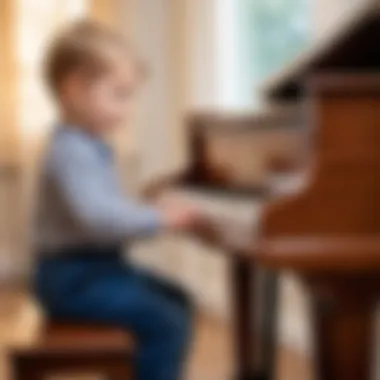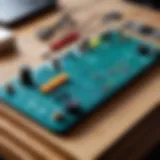Exploring Children's Toy Pianos: An In-Depth Guide


Intro
Children's toy pianos are more than just colorful playthings; they serve a fundamental role in early childhood development. This article offers an in-depth exploration of their many facets. From the various types available in the market to the hands-on benefits they provide in learning and entertainment, understanding these instruments can empower parents and guardians. As the landscape of children's toys shifts, so do the trends and features offered by manufacturers.
In this guide, we will highlight essential aspects such as the significance of toy pianos in auditory development, their role in fostering creativity, and emerging market trends. Our goal is to help families make informed decisions when choosing the right toy piano for their children.
Актуальные акции и скидки
Обзор текущих предложений
The market for children's toy pianos is dynamic, with frequent discounts and offers across various brands. Parents can often find appealing deals, especially during seasonal sales or special events. Observing current promotions can lead to significant savings while ensuring your child has access to quality educational toys.
When purchasing a toy piano, it is crucial to consider both price and value. This balancing act ensures that buyers receive a product that not only fits within budget constraints but also meets educational criteria.
Специальные предложения от популярных брендов
Brands like Hape, Melissa & Doug, and KidKraft often have special promotions. During these sales periods, consumers can capitalize on discounted prices for high-quality products. Sign up for newsletters or follow brands on social media to stay updated on the latest sales.
Рекомендуемые товары
Топ товаров со скидками
- Hape Kid's Wooden Toy Piano
This piano combines quality craftsmanship with vibrant colors. It offers a great introduction to music for young children. - Melissa & Doug Learn-to-Play Piano
This toy not only entertains but also educates through its easy-to-follow songbook. - KidKraft Grand Piano
This is an excellent option for aspiring musicians, with a design that encourages imaginative play.
Товары, которые стоит купить по сниженной цене
- B. Toy by Battat – Mini Maestro Piano
A compact option that is affordable and doesn’t skimp on features for young learners. - ALEX Toys – First Guide Piano
Offers a fun way for children to learn notes while playing.
By taking advantage of sales and understanding which products are worthwhile, parents can enhance their child’s development while being fiscally responsible.
Remember, investing in a toy piano is not just about fun; it’s a step toward building a child's appreciation for music and enhancing their cognitive skills.
As we delve deeper into the topic, we will explore the developmental benefits of toy pianos, discuss various types available, and highlight market trends that shape consumer choices. This knowledge will prove useful when making educated decisions on toy pianos.
Prelims to Children's Toy Pianos
Children's toy pianos play a significant role in early development, serving both as tools for entertainment and as instruments for learning. They introduce young minds to the joys of music, fostering creativity and engagement from an early age. Understanding the concept of toy pianos is essential for parents who wish to provide not just fun but also an educational experience through play.
Defining Toy Pianos
Toy pianos are miniature versions of traditional pianos designed for children. Typically smaller and lighter, these pianos are meant for young users to explore sound and music. The keys often have a simpler layout, and the range of notes is limited compared to adult-sized pianos. These instruments may include mini pianos, which can be purely mechanical, or electronic pianos, which may feature various sound effects and light-up keys. Overall, toy pianos are crafted to encourage an early interest in music and can enhance a child's sensory experiences during play.
Historical Evolution
The evolution of toy pianos can be traced back to the late 19th century, where they emerged as accessible instruments for children. The first toy pianos were often made of wood and had metal or wooden keys, producing a distinct sound that differs significantly from modern-day toy pianos. Over the decades, designs have shifted toward lightweight materials. Plastic and electronic components have become common, enhancing playability and feature sets. Prominent manufacturers like Schoenhut have influenced the market by introducing pianos that balance durability with musicality, making them appealing to children and parents alike. This historical context helps parents understand the transition from mere toys to educational tools that play a vital role in early childhood development.
The toy piano is more than just a child’s plaything; it is a gateway to a world of music, fostering skills that may last a lifetime.
In summary, the introduction of toy pianos in a child's life is marked by an evolution that reflects changes in technology and educational philosophy. These devices provide both entertainment and educational worth, enhancing a child's cognitive and motor skills while simultaneously introducing them to the world of music.
Types of Children's Toy Pianos
The categorization of children's toy pianos serves to highlight the diverse options available for young learners and their caregivers. Understanding the different types can guide parents and guardians in selecting the most appropriate piano based on the child's age, interest, and developmental needs. Each type offers unique benefits and features that cater to varying preferences.
Mini Pianos


Mini pianos are compact instruments designed specifically for toddlers and young children. Their small size makes them easily manageable for little hands. Typically featuring 25 to 37 keys, these pianos allow children to explore music without feeling overwhelmed.
Benefits of Mini Pianos:
- Portability: Their lightweight design means they are easy to move around. This allows children to play in various settings, be it at home or outside.
- Encouragement of Early Musicianship: The simplicity of mini pianos fosters an early interest in music. Kids can experiment with melodies without much formal training.
- Accessible Design: Many mini pianos come with colorful designs or themes that attract children and maintain their engagement.
Electronic Pianos
Electronic pianos represent a modern approach to learning music. These instruments often come equipped with a variety of sounds and features, making them a compelling option for older children who might already have a budding interest in music. The presence of volume control and headphone jacks also provides an avenue for more personalized play.
Advantages of Electronic Pianos:
- Variety of Sounds: Children can explore different instrument sounds, from traditional pianos to synthesizers and orchestral sounds, enhancing their musical experience.
- Learning Features: Many models include built-in learning modes, lessons, and connectivity with apps that can augment music education.
- Record and Playback Capabilities: Some electronic pianos even allow users to record their compositions for later playback, helping them to analyze and improve their skills.
Acoustic Toy Pianos
Acoustic toy pianos offer a traditional and organic sound experience. These instruments are often modeled closely after full-sized pianos, albeit in a smaller form. The sound production is purely mechanical, relying on strings and hammers to create music.
Key Aspects of Acoustic Toy Pianos:
- Authentic Sound Experience: For those who want to introduce their children to the fundamentals of piano music, the sound quality of an acoustic piano is often superior to that of electronic models.
- Durability: Many acoustic toy pianos are constructed from sturdy materials, making them a long-lasting option for enthusiastic young musicians.
- Aesthetic Appeal: These pianos often feature charming designs, adding to their allure as decorative items in playrooms.
Understanding these various types of children's toy pianos is crucial in making informed choices that align with developmental goals and musical interests. Parents can assess what features would appeal most to their children, leading to a more enriching experience.
Developmental Benefits
The role of children's toy pianos extends beyond mere entertainment. These instruments serve crucial developmental benefits which support a child's growth in several areas. While parents may view toy pianos as simple toys, their impact on cognitive, motor, and creative skills cannot be understated. Understanding these dimensions helps parents appreciate the significance of selecting the right toy piano.
Cognitive Skills Development
Engaging with toy pianos can greatly enhance cognitive skills in children. The process of learning to play introduces concepts such as rhythm and melody. When children press keys, they begin to understand cause and effect, as they see immediate results from their actions. This interaction stimulates brain development, particularly in areas related to auditory processing and memory.
Furthermore, as children experiment with sounds, they start to recognize patterns and relationships in music. This can translate into improved mathematical skills later on. Simple chords and notes can introduce young minds to basic music theory, fostering analytical thinking and problem-solving abilities. Studies show that children who engage with music show higher levels of academic achievement.
Motor Skills Enhancement
Playing a toy piano also offers substantial benefits for the development of fine motor skills. As young children reach for keys and press them, they practice coordination between their hands and fingers. This kind of physical engagement helps strengthen hand muscles, enhancing dexterity.
The act of playing requires a level of precision; thus, children learn to control their movements. This is not limited to finger exercises but also includes the way they position their bodies while playing. Activities such as lifting their arms to reach higher keys or moving their feet to tap along can improve overall motor skills. Coordination developed through play can positively affect other activities, including writing and drawing.
Creativity and Expression
Creativity flourishes when children have the tools to express themselves. Toy pianos provide an outlet for this expression, empowering children to explore their musical ideas freely. They can create their tunes and rhythms, allowing them to engage with music in a personal way.
The freedom of improvisation encourages children to experiment without the fear of making mistakes. This creative play promotes self-confidence, as each little composition becomes a unique reflection of their thoughts and feelings. A toy piano can become a child's first introduction to the world of music — a world where imagination meets reality.
Moreover, engaging with music from an early age reinforces emotional expression. Children learn to convey feelings like joy or sadness through the sounds they create, which is vital for emotional development. This enables them to better understand their own emotions and those of others.
"Music is a world within itself, it’s a language we all understand."
Market Trends and Popularity
Understanding the market trends and popularity surrounding children's toy pianos is essential for parents and guardians. The evolving landscape of childhood entertainment and education highlights a growing interest in musical instruments that cater to young children. This section provides insights into the current market, innovative features, and sustainability considerations. Each part is crucial in guiding consumers to make informed choices.
Current Market Landscape


The demand for children's toy pianos has seen a significant rise recently. Parents recognize the blend of fun and educational value in these instruments. The variety in the market ranges from classic wooden designs to modern electronic versions. Brands like Melissa & Doug and Fisher-Price have tailored their products to different age groups. They focus on quality, vibrant colors, and engaging sounds.
In terms of pricing, options exist across various budgets. This inclusivity allows more families to access these educational tools. Online platforms are instrumental for consumers. Websites such as Amazon and Walmart offer an extensive collection of toy pianos, making it easier for parents to compare features and prices. Reviews and ratings provide valuable information for choosing the best product.
Innovative Features
Toy pianos today are not just simple instruments. Many models now include innovative features that enhance play and learning. These features can make a toy piano more attractive to children.
- Interactive Elements: Some pianos have built-in lights that respond to playing, creating an engaging visual experience.
- Learning Modes: Certain brands provide educational modes for teaching notes or songs.
- Connectivity: Newer electronic pianos may allow connectivity to apps, enabling a more interactive learning approach.
- Quality Sound: Advances in sound technology are present in many models, providing richer tones that mimic real instruments.
These features contribute positively to a child’s music education. They encourage exploration and creativity, providing not only enjoyment but also educational benefits.
Sustainability Considerations
As environmental awareness grows, many manufacturers are making efforts to produce sustainable toys. Parents increasingly favor toy pianos made from eco-friendly materials.
- Material Sourcing: Companies are utilizing sustainable wood or recycled plastics.
- Production Practices: Ethical labor practices are becoming a focus in the toy industry, reducing environmental impacts during production.
- Durability: A focus on creating long-lasting toys reduces waste. High-quality materials ensure the pianos can withstand playful use over time.
Support for sustainable options aligns with the values of many families today. By choosing eco-friendly toys, parents can educate their children about environmental responsibility.
Ultimately, understanding market trends helps families stay informed about the best practices and products available for their children. The right toy piano can support creativity and learning while also being considerate of our planet.
Choosing the Right Toy Piano
Selecting an appropriate toy piano is a critical step for parents and guardians aiming to enhance their child's play and learning experience. The right choice can not only foster musical interest but can also be tailored to a child's developmental stage and safety needs. Understanding aspects such as age appropriateness, safety standards, and sound quality is essential in making an informed decision.
Age Appropriateness
When it comes to children's toy pianos, age appropriateness guides the selection process significantly. Each toy piano is designed with a specific age group in mind.
- Toddlers (1-3 years) will benefit from mini pianos with larger keys and fewer notes, as they are easier to handle.
- Preschoolers (3-5 years) can begin exploring electronic pianos that offer interactive features like lights and sounds.
- Older children (5-8 years) may appreciate more complex instruments that mimic real piano features, facilitating a deeper learning experience.
By choosing the right toy piano according to age, parents can ensure that the instrument is not only safe but also engaging for the child.
Safety Standards
Safety is another critical factor when selecting a toy piano. Products need to meet specific safety standards that safeguard children from potential hazards.
- Materials Used: Ensure the toy piano is made from non-toxic, durable materials. Avoid instruments with sharp edges or small components that can pose choking hazards.
- Certification Labels: Look for certifications such as ASTM, EN71, or CE. These labels indicate compliance with established safety protocols for children's toys.
- Age Ratings: Always adhere to the age ratings provided by the manufacturer to ensure the instrument is suitable for the child’s developmental level.
By prioritizing safety, parents can help create a worry-free environment where children can play and learn.
Sound Quality and Features
The sound quality and features of a toy piano can greatly influence a child's interaction with music. While fun features may catch a child's attention, sound quality will impact their auditory development.
- Basic vs. Advanced Models: Basic toy pianos may offer simple sounds, while advanced models often include a range of tones and sound effects. Consider what aligns with the child’s interests.
- Volume Control: Look for models that include volume control settings. This feature helps manage noise levels, which can be beneficial in a household environment.
- Educational Features: Some electronic toy pianos come equipped with additional learning modes that teach notes, scales, or even famous songs, making the instrument both enjoyable and educational.
Ultimately, a good toy piano should cater to the child’s musical exploration while enhancing their enjoyment and learning capacity.
Where to Buy Toy Pianos
Finding the right toy piano for a child may seem simple, but it involves several considerations. The availability and variety of options can affect the decision-making process. Understanding where to buy toy pianos is crucial to ensure you select the best instrument for your child. Different venues offer unique advantages when it comes to purchasing toy pianos, be it in-store or online. Pricing, quality, and customer service are all factors to take into account. Moreover, parents and guardians should prioritize convenience and the ability to assess quality firsthand.
Online Retailers


Online retailers are an increasingly popular choice for purchasing toy pianos. They offer a broad selection from various brands, which might not be available in local stores. Websites like Amazon and Walmart provide customer reviews, allowing parents to gauge the experiences of others.
- Convenience: Shopping online lets you browse at any time from the comfort of your home.
- Variety: You can compare many brands in one place, often with more choices than in physical stores.
- Price Comparison: Online platforms facilitate price checks across different sellers, enabling a more informed decision.
However, when shopping online, consider the shipping costs and the return policy in case the product does not meet expectations. It is essential to be cautious and purchase from reputable websites to ensure safe transactions and product quality.
Local Toy Stores
Local toy stores provide a distinct shopping experience. They allow customers to see, touch, and even hear the toy pianos in action before making a decision. Familiarity with the store’s reputation can be beneficial. It often allows for personalized customer service, where store associates can provide tailored advice.
- Immediate Gratification: Purchasing in-store means you can take the toy piano home immediately.
- Support Local Businesses: Choosing local stores contributes to the community and supports small businesses.
- Product Testing: Parents and children can try out the toy piano, ensuring it meets their needs.
While selections may be more limited than online, many children’s toy stores often include knowledgeable staff who can recommend options based on the child's age and skill level.
Comparison Shopping Techniques
Comparison shopping is essential when looking to purchase a toy piano effectively. It can ensure you are making a financially sound decision without compromising quality. Here are some techniques to consider:
- List Your Preferences: Before shopping, note the features that matter most, such as sound quality, materials, and size.
- Check Multiple Sources: Look at various online and local retailer websites for price differences and special offers. Websites like Reddit and specialized forums might have user discussions that offer insights as well.
- Utilize Price Trackers: Websites like CamelCamelCamel can show historical prices for items on Amazon, helping to identify the best time to buy.
- Read Reviews: Check expert reviews on platforms like Britannica and consumer articles which often highlight the best toy pianos in different categories.
By employing these techniques, consumers can make a wise decision and find a toy piano that meets both their child's needs and their budget. Comparison shopping becomes not just a task but a method to ensure satisfaction in the purchase.
Toy Piano Maintenance and Care
Maintaining a toy piano is essential for preserving its functionality and aesthetics. A well-cared-for piano not only ensures a pleasant sound experience but also extends its life, allowing children to enjoy music for longer. Parents should understand that maintenance involves both regular cleaning and proper storage. Neglecting these aspects can lead to performance issues or even damage, maring the educational and entertainment benefits of the instrument.
Regular Cleaning Practices
Regular cleaning practices are fundamental to keeping a toy piano in good condition. Dust and dirt can accumulate on the keys and the body of the piano, affecting both its look and sound. Here are some effective cleaning tips:
- Use a soft, dry cloth: Always start with a soft, dry cloth to wipe down the surface. This will help remove dust without scratching the material.
- Special cleaner for pianos: If stains persist, consider using a special cleaner designed for musical instruments. Ensure it is safe for children and follow the manufacturer's instructions.
- Avoid excess moisture: When cleaning, do not use too much water or cleaning agents. Excess moisture can damage the internal components of the piano, particularly in electronic models.
- Clean the keys regularly: The keys are often the most touched part of the toy piano. Regularly sanitizing them can minimize the build-up of germs and ensure a clean surface for play.
By adhering to these cleaning practices, parents can significantly enhance the longevity of the toy piano, allowing children to explore music safely and joyfully.
Storage Recommendations
Proper storage is equally important in maintaining a toy piano. The way it is stored can greatly impact its condition and performance. Here are several storage recommendations:
- Choose a dry, cool location: Humidity and extreme temperatures can warp the materials of a toy piano. A dry and cool location minimizes these risks and enhances the instrument's durability.
- Use a protective cover: When the piano is not in use, covering it with a protective cloth or cover can keep dust and debris from settling on its surface.
- Avoid direct sunlight: Placing the toy piano in a location exposed to direct sunlight may fade its color and degrade materials over time. Finding a shaded area can help maintain its appearance.
- Avoid stacking other items: Never stack heavy items on top of the piano during storage. This can lead to physical damage or misalignment of keys and other components.
By following these storage recommendations, parents can ensure their child's toy piano remains in excellent condition, ready for play whenever the urge for musical exploration arises.
"Caring for a toy piano today ensures memories of music tomorrow. Caring means cleaning and proper storage."
Implementing good maintenance and care practices allows families to optimize the joy of music education through toy pianos while emphasizing the importance of responsibility to children.
Closure: The Value of Toy Pianos
In considering the broad array of children's toy pianos, one must recognize their multifaceted value. Not only do they serve as instruments for entertainment, but they also act as cognitive enhancers, fostering essential skills in young minds. Toy pianos blend fun with learning, encouraging exploration and creativity. This combination is particularly important as children engage with music in their formative years.
The significance of toy pianos lies in their ability to support various developmental stages. They nurture a child’s cognitive growth through sound recognition and pattern association while boosting motor skills by requiring precise finger movements. Thus, they are not merely playthings; they are educational tools that can enrich childhood experiences.
Moreover, as parents and guardians become more aware of these benefits, the demand for well-designed and safe toy pianos has risen. This trend reflects an increasing acknowledgment of the importance of selecting toys that promote development over mere entertainment.
Recap of Key Points
- Role in Development: Toy pianos enhance cognitive, motor, and creative skills.
- Market Growth: Growing awareness of educational toy pianos is evident in current trends.
- Selecting Quality Products: Parents should prioritize safety and educational value when choosing toy pianos.
- Entertainment and Education: Toy pianos provide a harmonious balance of fun and learning.
Final Thoughts on Educational Benefits
The educational potential of toy pianos is substantial. Engaging with music during childhood leads to various cognitive benefits, such as improved memory and concentration. Music also opens avenues for children to express emotions and socialize with peers through shared musical experiences.
The right toy piano can ignite a passion for music that lasts into adulthood. Parents who invest in quality instruments early can foster long-term appreciation and understanding of music. Therefore, choosing a toy piano is not just buying a toy; it is an investment in a child's growth and future.



